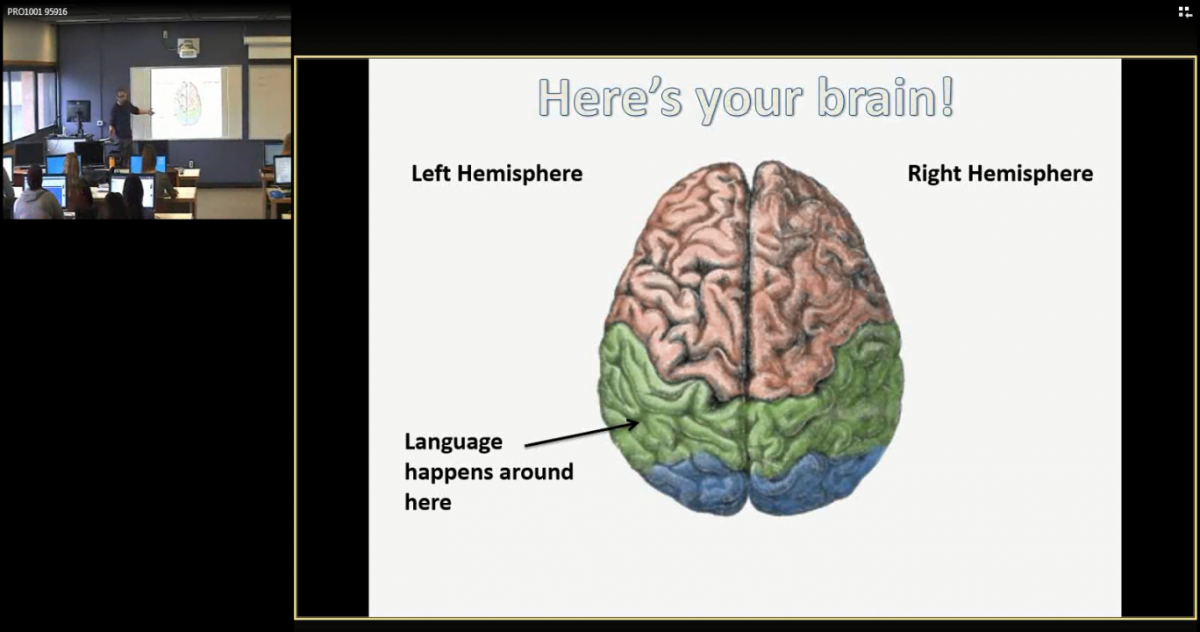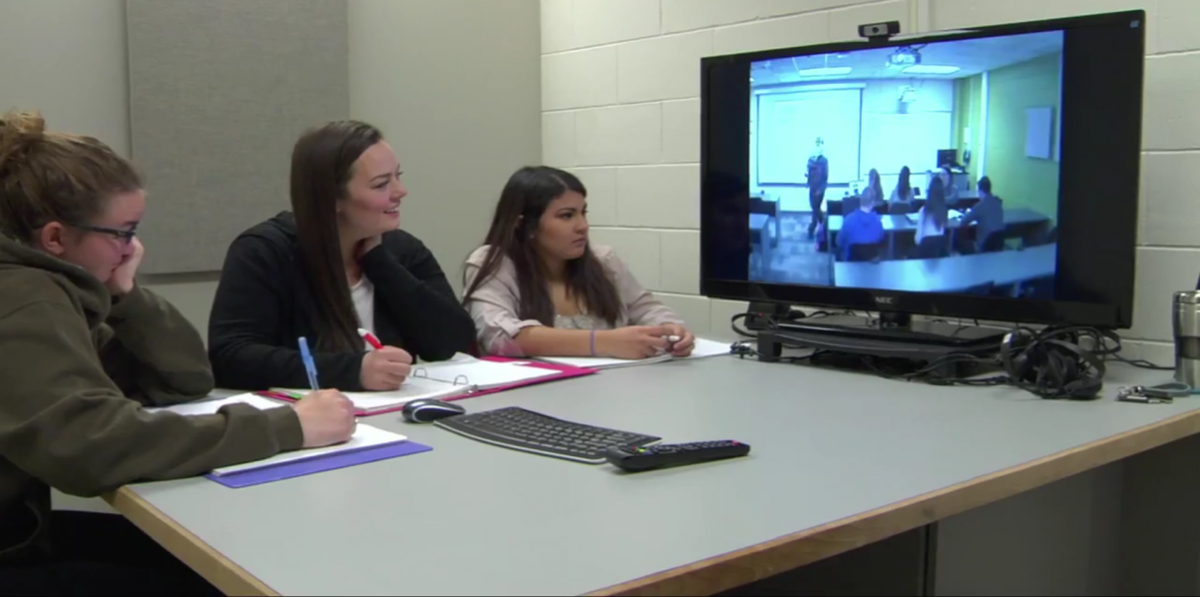Opportunity
As described by Joan Campbell, Dean, Schools of Business and Information Technology, Creative Arts and Design, and Hospitality at Cambrian College in Sudbury, “teaching and learning strategies, such as blended learning and flexible delivery, are essential in meeting the needs of our current and future students. Enhancing student engagement and access through technology has been and will continue to be explored by the College.”
The Flipped Classroom and HyFlex (in which the same course is available in multiple formats) delivery options are currently being piloted at the College. To support these developments, the technological infrastructure was installed and faculty training is being developed and assessed.
Innovation
Researching HyFlex Options: Students in the School of Business are able to choose how to “attend” each class in selected courses. They can participate in the live, in-class lecture, participate in the virtual lecture by viewing it in real time (synchronously), or watch the recorded lecture in their own time (asynchronously) within the limits of the course requirements. Students can alternate among these delivery methods for the duration of the course. All students get the same access to online materials, lecture notes, handouts, and can watch the recorded lectures for review purposes.
In January 2015, Cambrian College will research whether this range of delivery methods meets student needs or whether a fully designed online option is also necessary. Based on the HyFlex delivery used at San Francisco University and other American institutions, students will have the choice of taking a course:
- In-class;
- Virtually by participating in the in-class lectures synchronously;
- Virtually by watching the in-class lectures asynchronously;
- As a completely online course; or
- As a combination of these options.
The research will consider the student responses to assess if well-supported virtual classes provide a successful and supportive learning environment or if students prefer the structure of a course completely designed for online delivery. Impacts on the faculty and the College will also be studied.
Flipping the Classroom: In the academic year 2013-2014, the flipped classroom model was piloted at Cambrian. Nancy Griffin, Public Relations Program Coordinator and Professor, taught Introduction to Public Relations Theory, using taped lectures for the students to view outside class combined with class activities and discussions for the face-to-face sessions. Professor Griffin saw this course as well suited to the flipped model as there is considerable content that must be conveyed, and so class activities that support and extend learning are usually quite limited. To encourage the viewing of the lectures, she prepared guided lecture notes with some blank spaces the students completed in order to earn marks.
In class, the key points of the theory were reviewed and the rest of the time was spent in activities, such as looking at case studies and hearing guest speakers. The class was able to take field trips to events, such as the media conference for the launch of a local attraction, followed in the next class by an analysis of the event’s agenda, speakers, interest level, success, challenges, and alternate structures.
Providing the Infrastructure: Cambrian College invested in virtual classroom and break-out rooms to facilitate the recording, delivery, and interactivity of lectures and small group sessions. Using Microsoft Lync, a platform for online meetings, videoconferencing, instant messaging, and other communication links, professors can use one of the virtual classrooms and record their live lectures for virtual delivery and/or for review.

The small group sessions in the breakout rooms can be joined in real time by distant participants and recorded for later viewing.

Benefits and Outcomes
Researching High Flex Options: The research on high flex will address three specific issues:
- Student experience;
- Faculty workload; and
- Overall costs.
The experience of other institutions has indicated it is a beneficial approach.
Flipping the Classroom: The students appreciated how access to the recorded videos gave them much greater flexibility in time and location of viewing, as well as the capacity to use them for review and study. Being able to watch the lectures without the distractions that can occur in a class of 65 students was also seen as a benefit. Fifty-three (53) of the 65 students responded to the post-course survey, with 47 (or 89%) stating they preferred the recorded lectures.
Professor Griffin described the flipped classroom as, “freeing me up to be more creative.” She enjoyed bringing the content to life for the students, offering them experiences and opportunities for discussion they could not get in a lecture setting.
A group of professors involved in piloting the flipped classroom model at Cambrian College met to exchange their experiences. They reported that, although the students saw this model as more demanding, they also preferred the approach as it gave them the chance to participate. The professors discussed the importance of conveying to the students that they are responsible for their learning, the necessity of coming to class prepared to participate, and the equal importance of the two components of the course.
Providing the Infrastructure: The ability to live stream their lectures is appealing to professors. These virtual classrooms and break-out rooms are extensively used by departments across the College.
Challenges and Enhancements
Flipping the Classroom: In considering her experience with the flipped classroom, Professor Griffin determined, if she were to offer the course again, she would not flip every lesson. With the students getting the bulk of the theory from the online lectures, the in-class sessions had to be engaging and effective in order to ensure attendance and, in some cases, the content did not lend itself to strong in-class activities. She would make more judicious choices of which lessons would be flipped.
Teaching in the flipped model took far more time and work, as Professor Griffin spent four to six hours preparing for each module, creating the lecture, the guided lecture notes, and quiz, as well as determining and arranging the in-class components.
In a subsequent offering, instead of the guided lecture notes with a fill-in-the-blank quiz, she would fill the same purpose using scrambled questions. This would ensure the integrity of the student responses for marks.
The cross-college committee of professors offering flipped-classroom courses expressed concern about the demands on their time and the challenge of creating activities that are engrossing and educational for the face-to-face sessions. Making the link from theory to real-life experiences can be challenging, depending on the specific content of each lesson.
Potential
The challenge in introducing these teaching and learning options is providing the essential faculty training on approaches and techniques. A group of faculty are currently in a pilot test of a blended learning training model. The course is six hours a month for one semester of four months, looking at the pedagogical approaches, tools, and strategies. The course is offered in a blended format.
Joan Campbell underlines that, “the changing technology is very exciting, especially as a way of increasing access, but the challenge is ensuring quality – this is essential.”
For Further Information
Joan Campbell
Dean
Schools of Business and Information Technology,
Creative Arts and Design, and Hospitality
Cambrian College
[email protected]
Nancy Griffin
Coordinator and Professor
Public Relations program
Cambrian College
[email protected]


